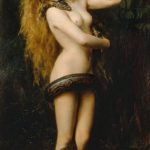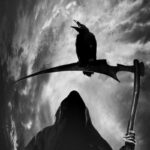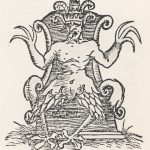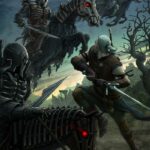Ankou (Ahn-koo) is the personification of death who comes to collect the souls of passed-over humans and bring them to the other side. Ankou is part of the fairy lore of the Celtic countries. He has largely been forgotten in Cornwall (Ankow), Wales (Anghau) and Ireland but remains part of the living folklore in French Brittany.
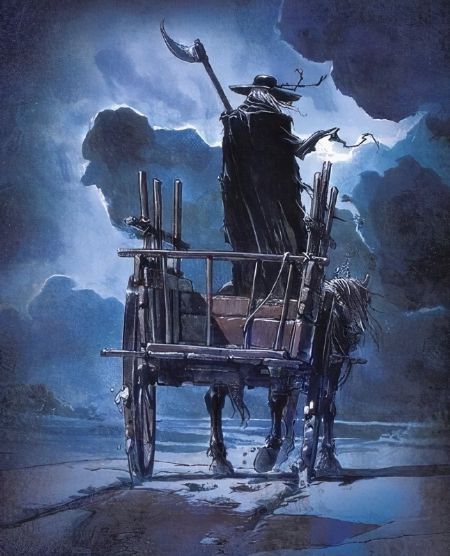
Origin
The Christian translators of folklore even connected the heritage of Ankou to the first blood spiller, Cain. According to the Hebrew Old Testament, Cain condemned man to death after slaying his brother.
A folk legend took this one step further, stating that Cain himself was cursed to walk the earth forever collecting the dead for penance, similar to the myth of the Wandering Jew.
Many believed that Ankou was Cain, forced to blindly search with his sense of smell for a late night wanderer. Other versions pretend that he is the first son of Adam and Eve.
In an alternate origin he was a cruel prince who met Death during a hunting trip and challenged him to see who could kill a black stag first. Death won the contest and the prince was cursed to roam the earth as a ghoul for all eternity
Description
Ankou is male dark, wearing a black-robed costume pulled up high about his head and a large hat that conceals his face. No one living has ever seen his face, for to do so would be to die. He is sometimes depicted as the Grim Reaper sporting a scythe with a handle of human bone.
His eye sockets, like smothering ashes, burned an eerie light because they had been taken out by an angel, angry when the Ankou had attempted to rip the soul from a good, untainted man.
Ankou drives a black cart( karr an Ankoù or karrig an Ankou), though some say it is really a small coach or even a hearse, pulled along either by two horses, one is old and thin, while the other is youthful and strong, or four black horses of unspecified age. However, Ankou may use a small boat (Bag Nez m night boat) when collecting souls on the shores after tempests.
It was said that some of the unfortunate souls harvested by the fearsome foreman were forced to aid him in his dark work, adding carcasses of family and friend to the great funereal mounds that laced a gigantic cart.
Ankou is always preceded by a cold gust of wind. Neither barroom brawler or gentle wife was foolish enough to leave the illusional safety of tavern or bedside if the creaking lull of a cart might be heard to break the deep silence.
To hear his knock foretold death in a family before the year was out. If a man or woman was unlucky enough to discover a red mark outside their door when emptying the urine bucket, it was a condemnation of approaching illness, and neighbors would shun such people for fear of bad luck. This “mark of Death” motif bares striking resemblance to the “warning marks” plague-infested European towns placed upon the walls and doors of families who were boarded up to die in their homes before the entire village was infected. Several people were thus starved, stabbed if they ran, or burned to death.
An old Irish proverb says, “When Ankou comes, he will not go away empty.” In Ireland, Ankou is always classified as a fairy rather than a ghost or some other type of spirit, and he is given more of a personality than he is accorded in many other lands.
Role
Collect the souls of those recently passed over and escort them into the Land of the Dead.
The Ankou is a Psychopomp. In this sense, he is more the henchman of Death than death itself. Myth abounds with many other creatures who walked the borderlands between life and death, guiding (or forcing) souls to the Land of Death. In some Southern regions of the United States, the bird known as a Harpy was thought to do this, in some instances carrying the unwilling soul to Hell.
In ancient Greek and Roman Mythology, Charon was one name for the lonely boatman who paddled souls across the river Styx in exchange for currency. In Europe, the Ankou was one of these twilight guides, so money and gifts were left as a forms of spiritual bribery.
The Ankou cut down man and woman, child and senior, without mercy. The notion that there was “always room for one more body” in his cart was perhaps the inspiration of the “prophetic dream” folk tale where a man or woman dreams of a sinister hearse driver whose words warn them of not taking the next day’s plane or bus.
According to Anatole Le Braz in The Legend of Death, the last dead of the year, in each parish, becomes the Ankou of his parish for all of the following year. When there has been, in a year, more deaths than usual, one says about the current Ankou:
War ma fé, heman zo eun Anko drouk. (“On my faith, this one is a nasty Ankou.”)
Stories
One says that there were three drunk friends walking home one night, when they came across an old man on a rickety cart. Two of the men started shouting at Ankou, and then throwing stones, when they broke the axle on his cart they ran off.
The third friend felt bad, and so wanting to help Ankou, first found a branch to replace the broken axle, and then gave Ankou his shoe-laces to tie it to the cart with.
The next morning, the two friends who were throwing stones at Ankou were dead, while the one who stayed to help only had his hair turned white. He would never speak in detail about how it happened.
One legend hinted that Ankou had once been a cruel landowner who foolishly challenged Death to a game of chance. A Prince, prone to fits of jealous anger and petty viciousness, loved to hunt. The moment of death, like the pain of his fellows, was as mother’s milk to him. One night, on the Sabbath, the man decided to have some sport in his forest.
While chasing a white stag, a magical animal found in several Celtic Fay stories, the man and his then-drunken companions stumbled across a massive figure drabbed in black atop a magnificent white horse (another symbol of death). The Prince challenged the silent man to a contest, angry at having found him on his land.
Whoever could kill the stag would not only keep the meat and hide, but could also determine the fate of the loser. The stranger readily agreed, his voice reminding the assembled men of the sound of leaves scraping against the castle walls.
The hunt was over so quickly that the Prince could only stammer. As hard as he had rode, the stranger had galloped faster. Through field and stream and mountain, the dark stranger remained in the lead, night winds tugging wildly at his cloak. And when the Prince was still stringing his bow, the stranger let his arrow loose with a dead whistle and a sickening tear of shredding flesh.
The vindictive Prince ordered his men to surround the stranger, bragging that he would bring two trophies back to his hall that night.
The stranger laughed.
“You can have the stag,” he said, “and all the dead of the world. Your joy is hunting? Hunt then! Your trophies will be found across battlefields and hearth, and they will reek of decay, huntsman.”

